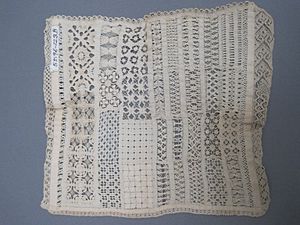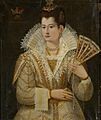Lace facts for kids
Lace is a beautiful fabric with open, holey patterns. It can be made by hand or by machine. Lace is usually very light and airy. Its designs often have many small holes and fancy edges called frills. People make lace by knitting, crocheting, or weaving threads together.
Contents
Types of Lace

There are many different kinds of lace. They are named based on how they are made. Here are some of the main types:
Needle Lace
Needle lace is made using a needle and thread. It is very flexible in its design. Some types can be made quickly, while others take a very long time. Many people think needle lace is the most artistic type of lace. The best old needle laces were made with super fine thread that is not made anymore.
Cutwork Lace
Cutwork (also called whitework) is made by cutting threads from a woven fabric. The threads that are left are then wrapped or filled with embroidery. This creates the lace pattern.
Bobbin Lace
Bobbin lace uses special tools called bobbins and a pillow. Bobbins are small spools made of wood, bone, or plastic. They hold the threads. The threads are woven together and held in place with pins stuck into a pattern on the pillow. The pillow is often filled with straw or other soft materials. A famous type of bobbin lace is Chantilly lace.
Tape Lace
Tape lace can be made in two ways. Sometimes, the "tape" part of the lace is made as you work. Other times, a machine-made or hand-made fabric strip is used. This strip is shaped into a design, then joined and decorated with needle or bobbin lace.
Knotted Lace
Knotted lace includes styles like macramé and tatting. Tatted lace is made using a small tool called a shuttle or a tatting needle. It creates strong, knotted patterns.
Crocheted Lace
Crocheted lace is made using a crochet hook. Popular types include Irish crochet, pineapple crochet, and filet crochet. These styles create beautiful, textured patterns.
Knitted Lace
Knitted lace is made with knitting needles. A well-known example is Shetland knitted lace. Some Shetland lace shawls are so fine that they can be pulled through a wedding ring!
Machine-Made Lace
Machine-made lace is any type of lace that is created or copied using machines. This allows for faster production.
Chemical Lace
Chemical lace is made by stitching a design with embroidery threads onto a special fabric. This fabric can dissolve in water or melt with heat. Once the stitching is done, the base fabric is removed, leaving only the embroidery as lace.
Images for kids
-
19th century lace
-
Unknown Holland painter, Portrait of woman, 17th century, National Gallery of Armenia
-
Early lace on a fragment of The Virgin and Child by Hans Memling.
-
Portrait of an Unknown Gentleman in Brown with a Lace Collar by Godfrey Kneller (1646-1723)
See also
 In Spanish: Encaje para niños
In Spanish: Encaje para niños
















